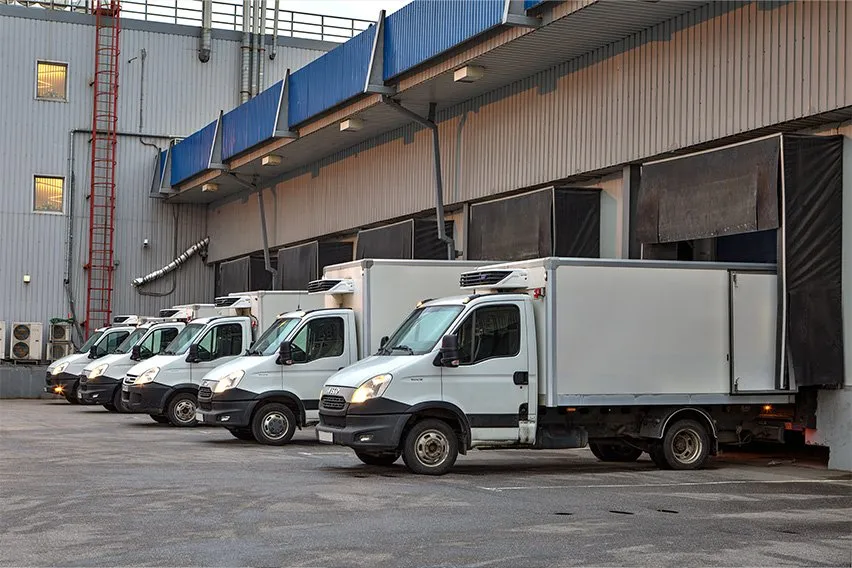How to Start a Transportation Business: 8 Easy Steps

Starting a transportation business offers a wide range of opportunities, from personal dispatch and moving services to large-scale freight operations. Whether you’re interested in passenger transport or logistics, there are numerous options available for new business owners. This guide will walk you through the essential steps to plan and successfully launch your transportation company from the ground up.
The transportation industry is vast, allowing for specialization in a particular niche or key area. For those with a specific interest in trucking, a dedicated guide on how to start a truck business is also available.
Key Takeaways
- To launch a transportation business, identify your niche, develop a strong business plan, and secure necessary funding and permits.
- Building a reliable fleet, utilizing digital technology, and assembling a qualified team are crucial for operational success.
- Invest in effective marketing and customer service to establish your brand and foster business growth.
- Transportation businesses involve moving goods or passengers and can specialize in areas like personal, local, or global transport.
- Choosing a specific niche and establishing a business model (sole proprietorship, partnership, or LLC) are initial critical steps.
- Securing a federal tax ID number (EIN) and applying for all necessary licenses and permits are vital for legal operation.
- Effective financial management, including setting a budget, securing funding, and making strategic purchases for your fleet, is essential.
- Implementing solid hiring practices and maintaining vehicles and certifications are crucial for long-term operational success and compliance.
- Common mistakes to avoid include ignoring interstate rules, neglecting comprehensive insurance, and failing to use contracts and waivers.
Table of Contents
- What Does a Transporting Business Do?
- 8 Steps to Launch Your Transportation Business
- Mistakes to Avoid When Starting a Transportation Business
- Start Your Transportation Business with Ease
What Does a Transporting Business Do?
Transport businesses are a type of business that transports goods or passengers from one location to another. They can provide services to individual passengers, other companies or global trade partners. A transport business could specialize in a number of activities, including individual rideshare services, hauling of consumer goods, or international shipping of supplies and products.
Most commonly, a transportation business is categorized by the type of customer base they serve or the type of routine service they provide. A transport and logistics business can offer a wide range of transportation services, including moving company operations, freight, and passenger transport.

Types of Transport Businesses
For the purpose of this guide, we’ll divide transport businesses into three main categories.
The types of transport businesses are:
- Personal transport: This includes one-on-one services catered to individuals or small groups, including things like taxi services, rideshare opportunities and limousines. Some entrepreneurs start with just one van to provide transportation services, focusing on transporting people. Transporting people requires selecting the right vehicle to ensure passenger comfort and safety.
- Local transport: This category serves regional markets by transporting things like livestock, materials, consumer goods and more. The opportunities might be commercial or private, depending on the distributed materials.
- Global transport: Global transport companies encompass aspects of the other categories but on an international scale. International providers may offer sea shipping or air-based delivery of cargo.
The types of transportation services that are most in demand can vary depending on local market needs.
Each category might require a unique knowledge of state, federal or even international laws to comply. Based on your interest and expertise, you can plan your next steps accordingly.
8 Steps to Launch Your Transportation Business
As you begin to plan how to start a transport business, make sure you pay attention to the things you will need to learn, study and acquire before you launch.
Neglecting any of these important pieces could lead to stress and challenges later on, so it’s important to prioritize setting a strong foundation. Below are eight steps you can take to start your transportation service company.
1. Decide on a Specific Transport Niche
As you begin your transportation business, the first step involves deciding who and what you will serve. You’ll need to answer the question, “What niche will I choose for my own transportation business?” As mentioned above, there are different categories of transport companies, and you may need to select only one in order to be successful. The best niche for your own transportation business may vary based on your skills, available resources, and the needs of your local market.
The best part about step one is that the possibilities are nearly endless! You can start anything from a bicycle rental company to a logistics corporation, a moving company, or a medical transport service. The critical element is that you choose one area and learn all that you can about it.
If you’re not sure what to choose, do some research about the supply and demand in your local area. Identify which transportation services are most in demand where you plan to operate. Providing the solution to a specific and relevant need or problem ensures that you’ll have a steady client base when it’s time to open.
2. Establish Your Preferred Business Model
Once you’ve chosen a niche and learned all that you can about it, you’ll need to move into the business model stage. Selecting the right business entity is a crucial step at this point. This is the time when you’ll set up your business structure and begin to fill in the operational information about your business.
When it comes to having a specialized business model in place, you have several options.
- Sole proprietorship: In this model, you work as an individual or married couple, but you do not incorporate. Although this offers flexibility, the downside is that any business losses may be assumed on a personal level, and you are personally liable for business debts and legal actions.
- General or limited liability partnership: In a partnership, you have the opportunity to go into business with others. A general partnership means all partners share management and are personally liable for the debts and obligations of the business. In contrast, limited liability partnerships offer some protection from personal liability for certain business debts or actions.
- Limited liability company (LLC): If you operate as an LLC, your personal and company information is entirely separate. This structure protects owners from personal liability for business debts and legal actions. While this changes your tax status, it does protect you from personal losses based on the company’s performance.
Keep in mind that in most states, the requirements for registering your business entity and obtaining permits may differ, so be sure to check local regulations.
3. Secure a Federal Tax ID Number
One of the first steps in your transportation service journey is setting up as an actual business. This means you need to secure a license from your local or state authorities. Because rules vary by location, you also need to consult your local government to find out how to apply for a business license.
From a federal standpoint, you need to apply for a federal tax ID number, or employer identification number (EIN), before you open for business.
The EIN process is fairly standard, and having this identification number:
- Makes it easier to file quarterly and yearly taxes
- Helps you file taxes more easily by keeping your business and personal finances separate
- Can protect you or your business from identity theft
- Speeds up the business loan application process
- Establishes business credit early on
- Allows you to build credit for your business, making it easier to obtain funding in the future
After obtaining your EIN, it’s important to open a business checking account and a business credit card. These tools help you manage your business finances, keep expenses organized, and build a strong credit history for your transportation business.
4. Apply for Licenses and Permits
When you begin your transportation service, you need to have the right licensure. There are specific permits required for different types of transportation businesses, and these requirements can vary depending on the state, vehicle type, and services offered. Why would transport businesses require more permits than other types of companies? The answer is that in many scenarios, you’ll be working with passengers, people and other types of precious cargo.
If you specialize in freight management or operations, the Department of Transportation has a specific list of requirements that you need to follow. This list is mostly based on the weight and size of what you’re hauling, and the permits required may vary depending on these factors.
Within the transportation industry, other types of licenses and permits might include:
- Commercial driver’s license (CDL), which is necessary for operating certain vehicles; requirements may vary depending on the type of business and vehicle
- Commercial vehicle registration for any fleet vehicle
- Fuel carrier licenses
- Heavy load or cargo permits
- Insurance coverage for drivers, passengers or goods
Trucking companies and logistics companies must adhere to strict licensing and permit regulations to legally operate. Understanding and obtaining all permits required is essential to ensure your business is compliant and avoids penalties or shutdowns.
5. Set a Budget and Financial Expectations
Based on the type of transportation business you choose, managing your finances effectively is crucial, and costs could be minimal or extensive. It is important to estimate your startup costs and determine how much funding you will need to launch your business, including expenses for vehicles and necessary modifications. To help with this, consider investing in robust transport accounting software. Running a one-vehicle taxi service is bound to be much cheaper than a full-fledged logistics fleet, but any type of business owner can plan for these costs. Be sure to watch out for hidden fees when budgeting and choosing financial products, as these can impact your overall expenses.
Do you need to obtain a loan to get started? The Small Business Administration is a great resource, and local banks or credit unions can also help. You will need to secure funding, so explore different financing options such as loans, grants, credit cards, or crowdfunding. Make sure to have a solid business plan established and on paper, since many lenders will ask to review this plan before considering a new loan application.
It’s also never too early to set financial goals and benchmarks. Developing a comprehensive financial plan is essential for understanding your projected financials and demonstrating your business’s viability to banks or investors. You need to consider:
- What you need to maintain to clear operating expenses
- How much to invest in supplies, equipment and manpower
- The specific amount of debt your business has in loans or other expenses
- What amount of money you’re willing to invest in marketing and advertising
- Managing paying employees, paying off credit cards, and handling other business expenses
6. Make Purchases and Build Your Fleet
Choosing the right vehicle for your specific business needs can set you up for profitability by giving your new business a professional look from day one. Vehicle size and quality matter, especially when you’re transporting goods and materials on behalf of other people. Selecting the right vehicle—considering factors such as size, type, and purpose—ensures it meets your operational needs effectively and legally. Additionally, investing in a reliable vehicle is essential to ensure smooth operations and maintain customer satisfaction. Showing up to a job with a vehicle that’s too small or inadequate (lacking refrigeration, space, etc.) can reflect poorly on your company.
Here are a few things to ponder as you make vehicle purchasing decisions and build your fleet.
- Will you need to transport any passengers?
- How heavy are the materials you’ll be transporting?
- What kind of ground or terrain do you need to cover on an average trip?
- What wear and tear might you need to expect on a regular basis?
- Are there any fuel-efficient or sustainable options to choose from?
- Have you planned for regular vehicle maintenance to ensure longevity and operational efficiency?
Take your time to research the best options based on quality, price and safety. All of these factors are extremely important as you establish your transportation business. Finally, make sure to obtain the best coverage for your vehicles by comparing comprehensive insurance options to protect your investment and business.
7. Establish Solid Hiring Practices
Your company’s hiring practices might evolve as your organization grows, but you always need to incorporate standard hiring procedures into your business plan. It is important to establish clear processes to hire people who are qualified and trustworthy for various roles. This helps formalize the process and ensures that you’re following local and state rules regarding employment.
Although your list of employees might include you and only a few others to begin, think about ways that your company could grow. In addition to drivers and service providers in the field, what other positions do you need to think about down the line?
These positions might include:
- Office and administrative staff
- A team of maintenance technicians
- Sales and marketing professionals
- Human resources (HR) staff
- Part-time or seasonal employees
8. Keep up with Maintenance and Recertifications
When you own a transportation business, you need to start with the future in mind. Although your supplies, vehicles and fleet might be brand new, long-term usage can affect both safety and quality. How will you keep up with routine maintenance to ensure that your customers don’t experience any gaps in service?
In addition to regular inspections, your company’s certifications and licenses may require renewal at various intervals. To stay compliant with legal requirements, and to keep your business functioning smoothly, you need to make sure that these are always up-to-date.
While it’s easy for the small details to get lost in the shuffle of everyday operations, setting up recurring reminders or putting a specific employee in charge of routine checks can prevent many problems.
Mistakes to Avoid When Starting a Transportation Business
If you follow the above steps, you’ll be better equipped to start a successful transportation business. As always, it’s a good idea to consult with a business or financial adviser as you make crucial decisions that could impact the health and longevity of your business.
Here are a few mistakes to avoid when starting your transportation business:
- Ignoring the rules of neighboring states and locations: As a transportation business, you may naturally need to cross state lines or operate in other jurisdictions. Be sure that you’re aware of the rules and license requirements in every state or place that you conduct business.
- Forgetting to insure every aspect of your business: While it may sound tedious to cover every item you haul, driver you hire or passenger you help, accidents do happen. General liability insurance can fill in gaps in situations where you don’t have a specific policy requirement.
- Failing to incorporate contracts and waivers: Business contracts can guarantee that you receive payment for services rendered. Additionally, these important documents set the tone for what to expect during a job or project. If you serve passengers, waivers can protect you legally in the event of a misunderstanding or accident.
- Not being transparent with pricing and including hidden fees: Customers value financial transparency. Avoid hidden fees and make sure your pricing is clear and upfront to build trust and avoid misunderstandings.
- Not keeping clients happy: Ensuring clients are happy with your service is essential for repeat business and positive reviews. Satisfied clients help build your reputation and support long-term success.

Start Your Transportation Business with Ease
We hope that this post has allowed you to envision a bigger and brighter future for your transportation business or service. In this industry, it’s entirely possible to start small and scale up—even going so far as to offer global services to customers around the world.
No matter where or how you begin, we invite you to dream up an incredible future for your transportation business. Using some of the tips and practical steps in this guide, you’ll be on your way to establishing a strong foundation. As you use this information, continue to be proactive with new opportunities for growth, learning and leadership.
Did you find this article helpful? If so, you might be interested in our guide titled How to Charge for Moving Services. This comprehensive guide provides a detailed explanation of moving job costs, which can be crucial for the growth of your transportation business.
RELATED ARTICLES

 How to Start a Successful Trucking Company
How to Start a Successful Trucking Company How to Start a Consulting Business
How to Start a Consulting Business How to Start a Farm: Grow Your Farming Business from the Ground Up
How to Start a Farm: Grow Your Farming Business from the Ground Up How to Start a Business: From Registering to Launching a Startup
How to Start a Business: From Registering to Launching a Startup Essential Skills Every Entrepreneur Should Have
Essential Skills Every Entrepreneur Should Have How to Start a Business for Social Good
How to Start a Business for Social Good